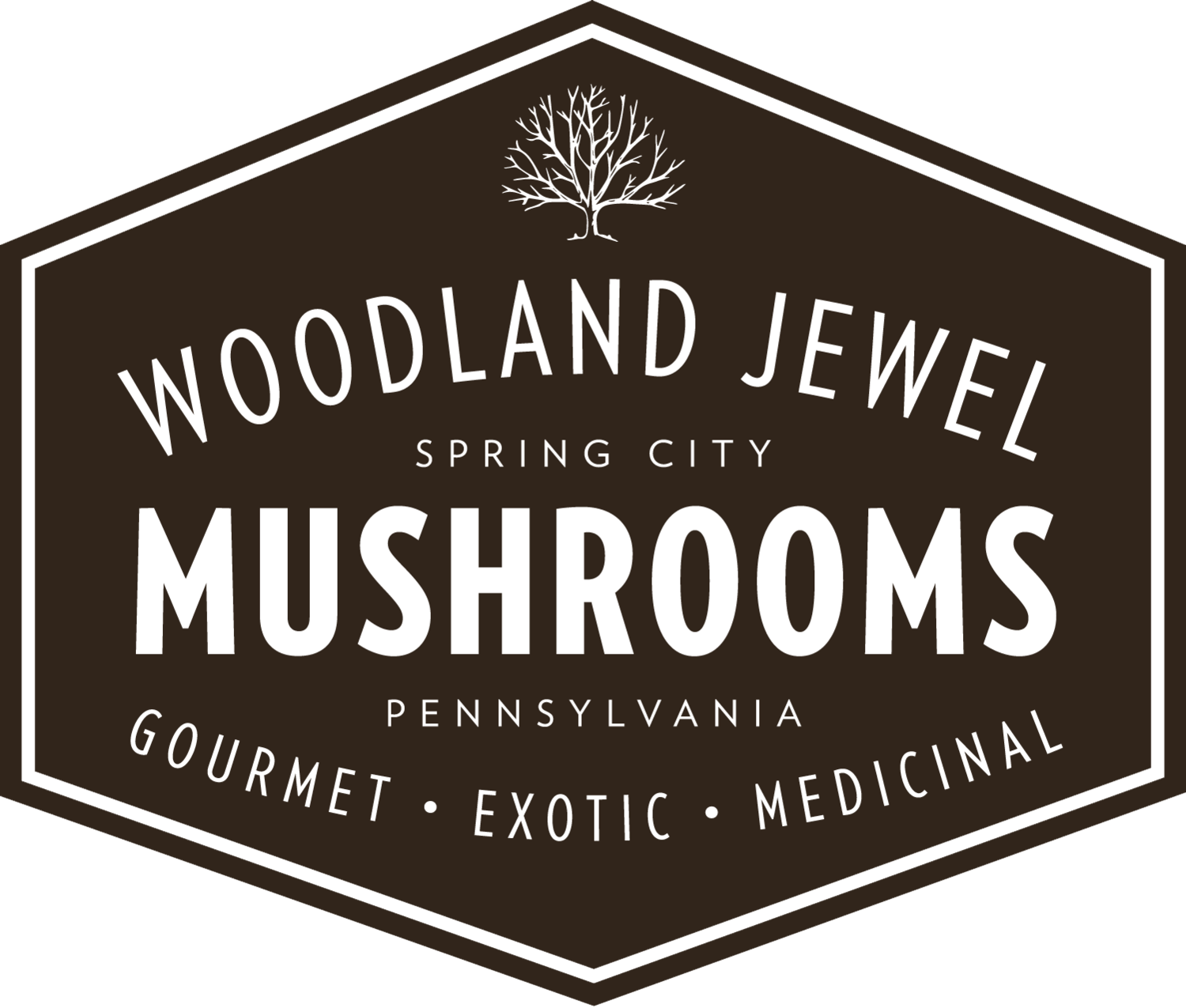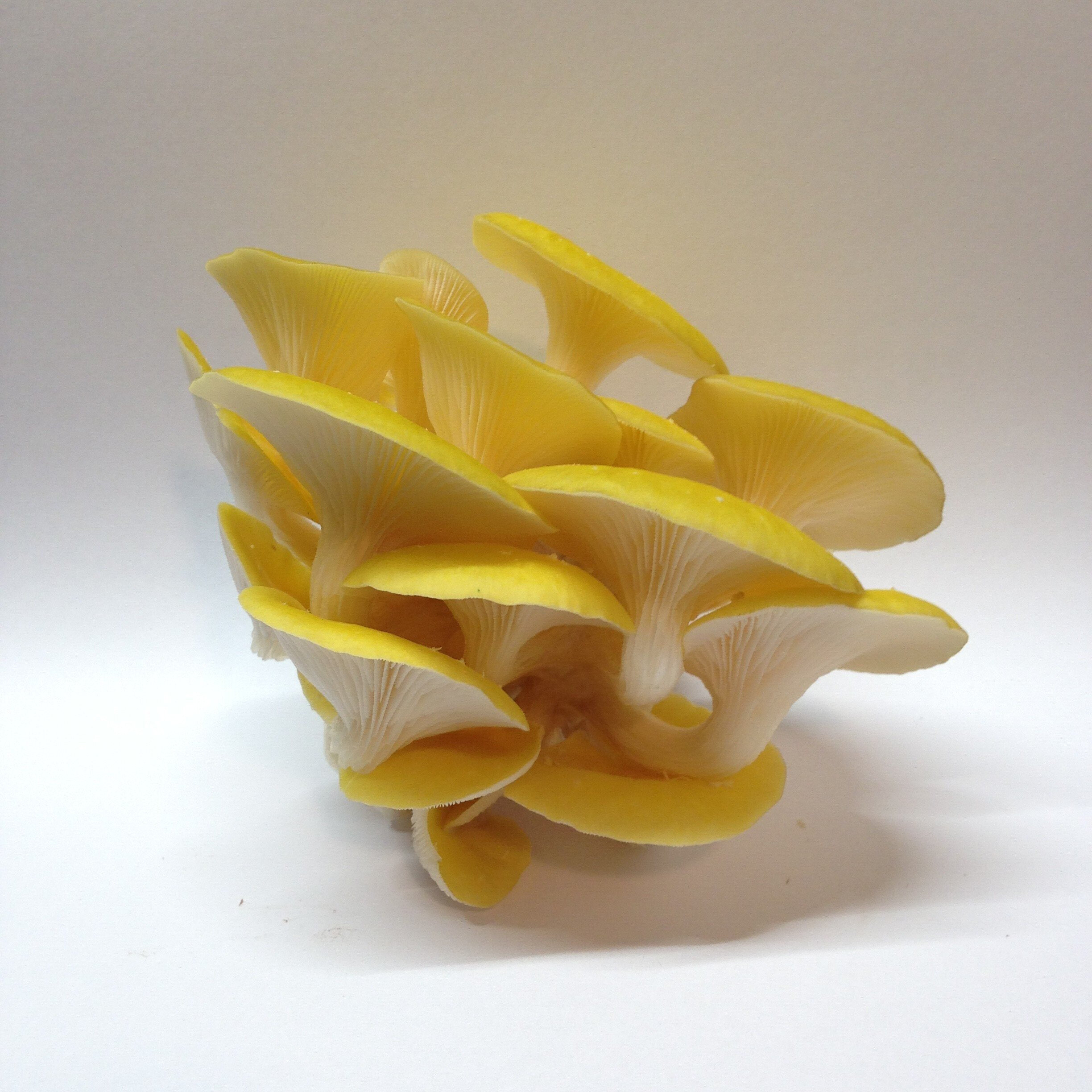Our Mushrooms
GOLDEN OYSTER MUSHROOMS
(Pleurotus citrinopileatus)
NUTRITIONAL VALUE
Golden oyster mushrooms contain beneficial minerals including copper and zinc. They also encompass essential amino acids such as folic acid (a B vitamin), lovastatin (which lowers cholesterol), and carotenoids which gives the mushrooms their beautiful vibrant yellow/gold color and also helps reduce the risk of certain cancers and eye disease in humans. Oyster mushrooms aid in lowering cholesterol levels, alleviate inflammation, boost brain health, help block cancer growth, and also are packed with antioxidants.
APPLICATIONS
Golden oyster mushrooms are best suited for cooking such as braising, boiling, stir-frying, and sautéing. When preparing oyster mushrooms, they should be gently cleaned with a damp towel or soft brush. Stems can be bitter so remove them if you choose to. They have a slightly nutty flavor compared to the more mild taste of silver oysters. Golden oysters are versatile and can be a substitute for button or other oyster mushrooms.
ORIGIN
Oyster mushrooms are native to northern China, Japan, and eastern Russia. However, today yellow oysters can be found at local markets in the U.S., Europe, Asia, and Southeast Asia.
INTERESTING FACTS
Oyster mushrooms are being studied and grown in regions of the earth where the land has been overrun by toxins. Oyster mushrooms have successfully cleaned soil of crude oil after spills, PCP, wastewater, and pesticide contaminated areas. The mushrooms mineralize the pollutants so that they can return into our atmosphere as healthy byproducts. Scientists believe mushrooms can be a natural way to alleviate environmental degradation.
Sliver Oyster Mushrooms
(Pleurotus ostreatus)
NUTRITIONAL VALUE
Silver oysters are proven to lower cholesterol levels and help reduce the risk of cancer. Oysters contain statins which helps reduce “bad cholesterol” which stimulated receptors in the liver and clears cholesterol from the body. Additionally, oysters create an anti-tumor effect due to their polysaccharides. The specific polysaccharide found in oysters to reduce tumors is called beta-D-glucans and when it is isolated from oyster mushrooms it is called pleuran. Pleuran is being used in cancer treatments and is having positive results however, studies are still taking place.
APPLICATIONS
Silver oysters are best suited for sautéing, braising, pan-searing, or frying. They have a meaty texture and somewhat taste like chicken. To prepare, they should be gently blotted with a damp cloth or gently brushed. Silver oysters can be a great substitute for meat dishes and contain protein, vitamins, minerals, and are very low in fat.
ORIGIN
Silver oysters are common in Asia, North America, and Europe
INTERESTING FACTS
Silver oysters are saprotrophs which means they feed on dead and decaying matter, mainly wood. Their caps range from two to ten inches and are shaped like a fan or an oyster. Pleurotus ostreatus means “sideways oyster.” Like golden oysters, silvers also absorb pollutants in the ground. Oyster mushrooms are powerful absorbers of mercury and once absorbed they are then picked and destroyed and the mercury is then removed from the environment.
SHIITAKE MUSHROOMS
(Lentinula Edodes)
NUTRITIONAL VALUE
Shiitake’s contain fiber, B vitamins, a few minerals all while being low calories. Shiitakes also contain the same amino acids as meat. In addition, they are cholesterol lowering, cancer preventing, immune boosting fungi and are commonly found in almost any grocery store.
APPLICATIONS
Second most cultivated edible mushroom, the shiitake tastes great dried or cooked. They are famous for their earthy, smoky flavor and meaty texture. Shiitakes taste best when they are sautéed lightly to maintain their flavor and nutritional profile.
ORIGIN
Native to East Asia
INTERESTING FACTS
Considered one of the healthiest foods, roughly eighty- three percent of shiitakes are grown in Japan but are also grown in the U.S., Canada, China, and Singapore. Shiitake mushrooms contain chemical compounds that protect DNA from oxidative damage and help cardiovascular health as well. They contain all eight amino acids and including linoleic acid which aids in weight loss.
LIONS MANE AKA POM-POM MUSHROOMS
(Hericium erinaceus)
NUTRITIONAL VALUE
Known to improve memory and mood, these white puffy mushrooms contain roughly twenty percent protein. Lion’s mane mushrooms are packed full of antioxidants which may fight inflammation and oxidation in the body. Best prepared by sautéing, pan searing or braising, lion’s mane mushrooms are very meaty and juicy when cooked properly.
APPLICATIONS
One of the few that can taste like lobster or shrimp. Lion’s mane is best when caramelized in olive oil, de-glazed with sake wine and butter to taste as a finishing touch. This mushroom should be cooked until it is crisp on the edges- if not, it can be bitter.
ORIGIN
Lion’s mane was first discovered in North America however, this funky fungi also grows in Japan, China, and Europe.
INTERESTING FACTS
Scientific studies have shown lion’s mane mushrooms offer a number of nootropic (mind-affecting) benefits which help boost cognitive function and memory enhancement. Lions mane are also considered the world’s first “smart mushroom” which means they have been proven to improve nerve regeneration and cognitive functions including seizures, depression, anxiety, cramps, spasms, and many more.
BLACK POPLAR AKA PIOPPINO MUSHROOMS
(Agrocybe aegerita)
NUTRITIONAL VALUE
Black poplars are rich in fiber, copper, B5 and have anti-fungal and antibiotic properties. Poplars also contain potassium, biotin, folate, iron, selenium, and vitamins B2 & B3.
APPLICATIONS
Black Poplar mushrooms are most commonly used for roasting, sautéing, braising, stewing, or pan-roasting. During preparation, they should be sliced from their hard base and brushed/wiped with a damp towel to remove excess debris. However, unlike many mushrooms, their stems are completely edible. Washing black poplars changes their texture so be sure to only use a damp cloth or brush. Poplars can be stored in a paper bag in the refrigerator for up to five days. They can also be dried and stored up to six months.
ORIGINS
Black poplars are native to Asia, especially Japan and China. They have been growing since ancient times and today are widely cultivated and sold in markets in the U.S, Asia, Europe, and Australia.
INTERESTING FACTS
Black poplars are used in traditional Chinese medicine. They reduce symptoms of nausea, fevers, and headache. They promote digestive health, strengthen kidneys, reduce inflammation and have anti-fungal properties. Black Poplar mushrooms were also cultivated by the ancient Romans.





